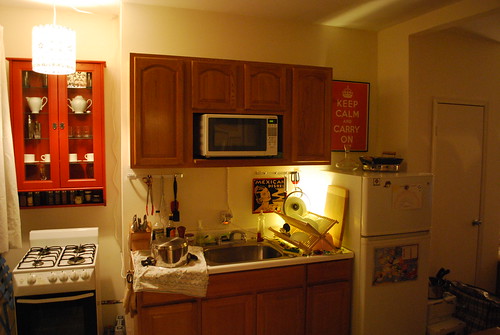
Some of you may have seen in when I posted pictures of my new place:

When I was still living in London, I bought this poster online, but because I can't access Etsy at work where I had seen many prints for sale, I had to find another vendor. And I really lucked out because not only was my print cheaper (£4.99) but I ended up buying it from Barter Books, the bookstore that discovered it. The story behind this poster is really interesting so I've included here and if you want you own poster just click here! (and wouldn't you know, the poster is now only £3.60!)
"In the spring of 1939, with war against Germany all but inevitable, the British Government's Ministry of Information commissioned a series of propaganda posters to be distributed throughout the country at the onset of hostilities. it was feared that in the early months of the war Britain would be subjected to gas attacks, heavy bombings raids and even invasion. The posters were intended to offer the public reassurance in the dark days which lay ahead.
The posters were to be uniform in style and were to feature a 'special and handsome' typeface making them difficult for the enemy to counterfeit. The intent of the poster was to convey a message from the King to his people, to assure them that 'all necessary measures to defend the nation were being taken', and to stress an 'attitude of mind' rather than any specific claim. On the eve of a war which Britain was ill equiped to fight, it was no possible to know what the nation's future aims and objectives might be.
At the end of August 1939 three designs went into production with an overall print budget of £20,600 for five million posters. The first poster, of which over a million were printed, carried a slogan suggested by a civil servant named Waterfield. Using the crown of George VI as the only graphic device, the stark red and white poster read 'Your Courage, Your Cheerfulness, Your Resolution will Bring us Victory'. A similar poster, of which around 600,000 were issued, carried the slogan 'Freedom is in Peril'. But the third design, of which over 2.5 million posters were printed, simply read 'Keep Calm and Carry On'.
The first two designs were distributed in September 1939 and immediately began to appear in shop windows, on railway platforms, and on advertising hoardings up and down the country. But the 'Keep Calm' posters were held in reserve, intended for use only in times of crisis of invasion. Although some may have found their way onto Government office walls, the poster was never officially issued and so remained virtually unseen by the public- unseen, that is, until a rare copy turned up more than fifty years later in a box of old books bought in at auction by Barter Book in Alnwick.
Shop owners Stuart and Mary Manley liked the poster so much that they had it framed and placed near the till in Barter Books. It quickly proved so popular with customers and attracted so many enquiries that in 2001 Stuart and Mary decided to commission a facsimile edition of their original poster which has since become a best-seller, both in the shop and via the Internet.
The Ministry of Information commissioned numerous other propaganda posters for use on the home front during the Second World War. Some have become well-known and highly collectible, such as the cartoonist Fougasse's 'Careless Talk Costs Lives' series. But ours has remained a secret until now. Unfortunately, we cannot acknowledge the individuals responsible for the 'Keep Calm' poster. But it's a credit to those nameless artists that long after the war was won people everywhere are still finding reassurance in their distinctive and handsome design, and the very special 'attitude of mind' they managed to convey. "

No comments:
Post a Comment